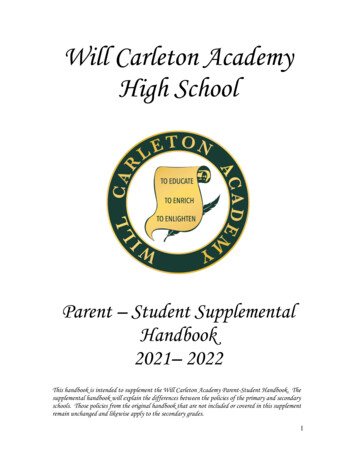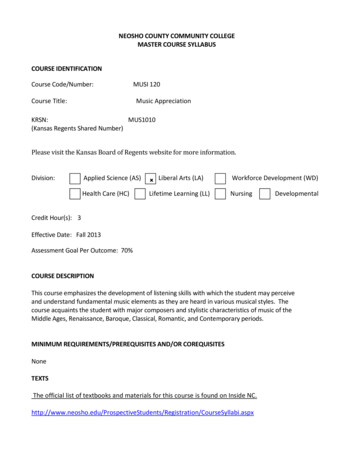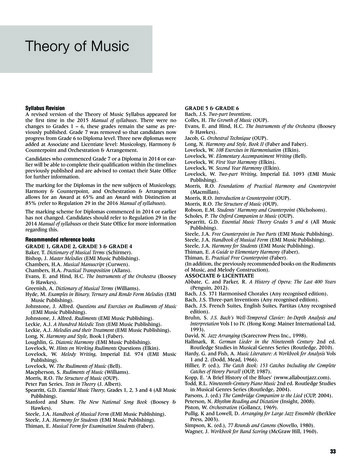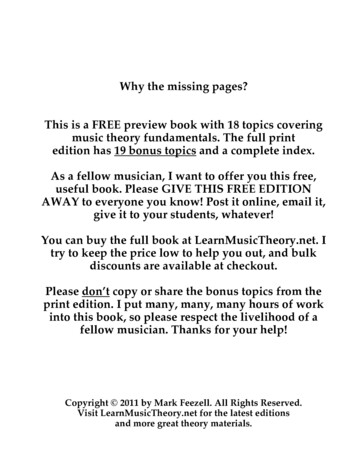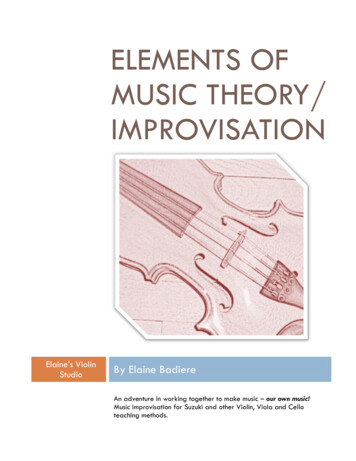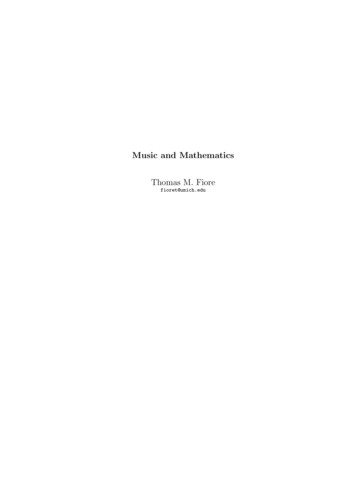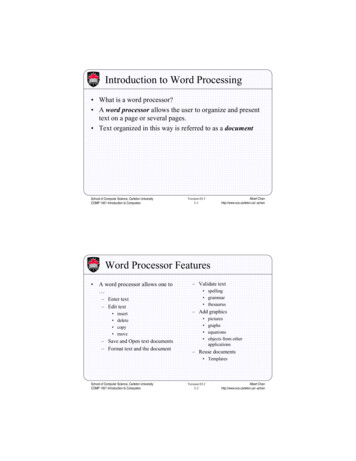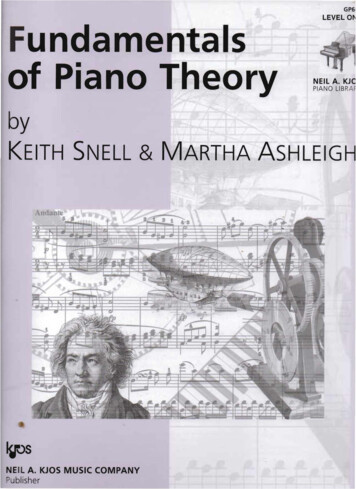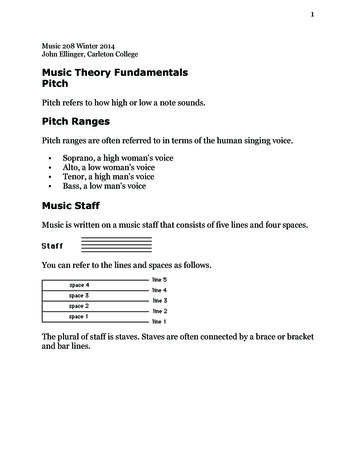
Transcription
1Music 208 Winter 2014John Ellinger, Carleton CollegeMusic Theory FundamentalsPitchPitch refers to how high or low a note sounds.Pitch RangesPitch ranges are often referred to in terms of the human singing voice. Soprano, a high woman's voiceAlto, a low woman's voiceTenor, a high man's voiceBass, a low man's voiceMusic StaffMusic is written on a music staff that consists of five lines and four spaces.You can refer to the lines and spaces as follows.The plural of staff is staves. Staves are often connected by a brace or bracketand bar lines.
2Lines And SpacesNotes can be drawn on a line or a space. A note on a line is centered on theline. A note in a space is contained within the space between the lines.In hand written music be careful to center notes on the line or draw themcompletely within the space. Otherwise, the note is ambiguous. Are thefollowing two notes on lines or spaces?Ledger LinesLedger lines are used to extend the range of the staff. Ledger lines canappear above or below the staff. They maintain the spacing of the staff linesand extend slightly beyond each note head. Ledger lines never extend
3further than necessary.Low / HighThe higher up the staff the note appears, the higher the pitch.Musical AlphabetThe musical alphabet consists of the letters A B C D E F G. Each lettercorresponds to a specific line or space on the staff. As you move forwardthrough the musical alphabet the pitch of each note gets higher. You couldarbitrarily assign any staff line or space to represent the note A. The namesof the other lines and spaces would follow from there.ClefsA clef symbol is placed at the beginning of each staff to fix the location of aspecific pitch on a specific staff line. The two most common clefs are theTreble and Bass clefs.
4When we put clefs into the example given earlier we get the musicalalphabet from A to G in each of these four clefs.Choice Of ClefsClefs are chosen to match the range of a voice or an instrument so that themajority of notes fall within the staff.When these notes are notated in treble clef many ledger lines are necessary.However, they fit nicely in the bass clef.Treble ClefTreble clef is part of a family of clefs known as G clefs. The curl in the trebleclef symbol locates the note G on the staff.The names of notes on the lines of the treble clef (EGBDF) can beremembered by the sayingEvery Good Boy Does Fine or Elvis' Guitar Broke Down Friday.The names of notes on the spaces of the treble clef (FACE) spell FACE.
5When the line and space notes are combined, they form the musicalalphabet.Instruments that use the treble clef include the piano (right hand), violin,flute, trumpet, and guitar.Bass ClefThe two dots in the bass clef symbol locate the line that represents the pitchF. Because it defines the pitch F, the bass clef is referred to as a F clef.The names of notes on the lines of the bass clef (GBDFA) can beremembered by the sayingGood Boys Do Fine AlwaysThe names of notes on the spaces of the bass clef (ACEG) can beremembered by sayingAll Cows Eat Grass or All Cars Eat Gas.When the line and space notes are combined, they form the musicalalphabet.
6Instruments that use the bass clef include piano (left hand), cello, bassoon,and tuba.Piano KeyboardThe piano keyboard consists of 88 keys arranged in repeating groups ofwhite keys and black keys. Low notes are on the left side of the pianokeyboard. High notes are on the right side of the piano keyboard. As youmove from left to right on the piano, the pitch of each note gets higher.Black Key GroupsThe black keys of the piano are arranged in groups of twos and threes.Using these black key groups you can identify any note on the keyboard.For example, C is always the white key immediately to the left of a two blackkey group, and A is always between the second and third black key in athree black key group.Keyboard White KeysThe white keys on the piano correspond to the musical alphabet A B C D EF G. You can always locate the note A on the piano by finding a group ofthree black keys and then playing the white key between between thesecond and third black key. Then names of the other white keys follow from
7there. The musical alphabet is repeated a little over seven times on thewhite keys of the piano keyboard.Middle CMiddle C is the C that is found in the middle of the piano keyboard.Pitch, Clefs, Staff, And Keyboard CombinedIn each clef there is an exact correlation between the letters of the musicalalphabet, the notes on the staff, and the piano white keys. As the pitch ofeach note rises, you move forward through the musical alphabet, you moveto the right on the piano, and you move up on the musical staff. Notice thateach letter name has its own white key on the piano and its owncorresponding place on the music staff.Treble Clef Range On The Piano
8Bass Clef Range On The Piano.Half StepsThe half step is the smallest unit of pitch used in Western music. Half stepsoccur naturally on the piano between any two adjacent piano keys, white toblack, black to white, or white to white.
9Naturally Occurring Half Steps (Nohs)Two half steps occur naturally in the musical alphabet A B C D E F G,between B-C and E-F. They are referred to as Naturally Occurring HalfSteps, NOHS. On the piano they are the white keys pairs that do not have ablack key between them.Whole StepsTwo consecutive half steps make a whole step. Whole steps occur on thepiano between the first and third key of any three adjacent piano keys,white to white, black to black, white to black, or black to white.E - F#White BlackBb - CBlack WhiteD-EWhite WhiteGb AbBlack Black
10Naturally Occurring Whole Steps (Nows)Whole steps occur naturally on the piano white keys, and in the musicalalphabet A B C D E F G, between every letter pair except B-C and E-F.There are five pairs of naturally occurring whole steps: A-B, C-D, D-E, F-G,and G-A.Visual Recognition Of Whole Steps And Half StepsNotice that it's impossible to visually distinguish whole steps and half stepson a music staff without a clef.You need to know the clef in order to know where B-C and E-F are.
11IntervalsAn interval is the distance between two notes. The size of an interval ismeasured in half steps. The size of a half step is one half step. The size of awhole step is two half steps.OctaveAnother important interval is the octave. An octave is the interval betweentwo notes that have the same name and are twelve half steps apart. If youstart on any note of the piano and then play twelve successive half steps upor down you'll reach the note that has the same name as the one you startedfrom. Those two notes are an octave apart. The root "oct" refers to the factthat an octave spans eight alphabet letters. An 88 key piano has a range ofseven and a half octaves. We'll be studying more about intervals in Unit 11.AccidentalsAccidentals are symbols that alter the pitch of a note. Five accidentals areused in music notation: the flat, sharp, double flat, double sharp, andnatural.
12NameSymbol EffectFlatlowers pitch by half stepSharpraises pitch by half stepDouble Sharpraises pitch by whole stepDouble Flatlowers pitch by whole stepNaturalcancels previous accidentalIn music notation accidentals precede the note they affect. However, inspeaking or text the accidental follows the note name. You say or write "Gsharp" or "G#", not "sharp G."Single AccidentalsSingle accidentals raise or lower the pitch of a note by a half step. They areare the sharp, flat, and natural. Single accidentals are very common inmusic.Double AccidentalsDouble accidentals raise or lower the pitch of a note by two half steps orone whole step. They are are the double sharp and double flat. Double
13accidentals are much less common than single accidentals.NaturalThe natural is used to cancel a previously used sharp or flat. The followingexample illustrates an important musical rule.Rule: Once an accidental is used within a measure it remains in effect untilyou reach the end of the measure or it is altered by another accidental.Accidentals And Keyboard Black KeysMost, but not all, accidentals that appear in a piece of music are played onthe black keys of the piano. The key immediately to the right (higher pitch)of any white key is called that key sharp. For example, the black keyimmediately to the right of D is called D#.The key immediately to the left (lower pitch) of any white key is called thatkey flat. For example, the black key immediately to the left of E is called Eb.Because there is only one black key between D and E, that black key has twodifferent names. You cannot hear the difference between D# and Eb, butyou can see the difference when they are written.
14Names Of Black KeysBlack keys can be named with either sharps or flats. On the piano keyboardthe black key between C and D can be thought of as a half step higher thanC and called C# or as a half step below D and called Db. The names of theblack keys using sharps would b: C# D# F# G# A#. The names of the sameblack keys using flats would be: Db Eb Gb Ab Bb.Enharmonic NotesTwo notes that sound the same but have different names are calledenharmonic notes. A# is the enharmonic equivalent of Bb.The piano is an enharmonic keyboard because every key of the piano canrepresent three notes with the exception of G#-Ab.
15B# and C are enharmonic notes. In this case B# is the same white key as C.Other enharmonic white key pairs are: E#-F, B-Cb, and E-Fb.Chromatic ScaleThe chromatic scale is the scale of half steps. When you play every blackand white key on the piano in sequence, you're playing the chromatic scale.Here's the chromatic scale from A to A written first using sharps, then usingflats. In the second example, note the use of the natural sign to cancel theflat on the previous note.
16When writing an ascending chromatic scale, sharps are preferred. Whenwriting a descending chromatic scale, flats are preferred. The preferredform keeps the number of accidentals to a minimum.Diatonic/Chromatic Half Steps And Whole StepsHalf steps and whole steps can be further classified as diatonic orchromatic. The distinction lies in the alphabet letter name of the notes. Ifthe two notes have different alphabet letter names they are diatonic. If theyhave the same alphabet letter name they are chromatic.Grand StaffThe grand staff consists of the treble clef and bass clef joined by a brace. Allpiano music is written using the grand staff, treble clef for the right handand bass clef for the left hand.
17In the early history of music notation, an ancestor of the grand staff was theeleven line staff. It's hard to read an eleven line staff quickly. Is the last noteon the 7th, 8th, or 9th space?If you split the eleven line staff in the middle and move five lines up andfive lines down it's much easier to identify specific lines and spaces.When you erase the middle line, add the treble and bass clefs, and jointhem with a brace you get the grand staff.
18Here's the eleven line example in the Grand Staff.Although Middle C is an invisible staff line shared between the treble andbass clefs, Middle C is never written in the middle of the grand staff. It iscorrectly written using ledger lines above or below the staff. Ledger linesare spaced the the same distance apart as the staff lines.Pitch NamesTo uniquely name a pitch you have to identify three things, the alphabet
19name, the accidental (if used), and the octave designation. Several systemsof pitch names have been used. We'll use a common one that definesmiddle C as C4. All other note names derive from that. The octavedesignation changes on every C.Piano Keyboard ReferenceA0C1C2 C3 C4 C5 C7 C6 C8 8VaIf you look closely at the music example shown above, you'll see the symbol8va placed either above a note or below a note. The 8va symbol is Italian forottava, or octave. When it is placed above a note, the note is played oneoctave higher. When it is placed below a note, the note is played one octavelower. It is commonly used to reduce the number of ledger lines needed towrite very high notes or very low notes.Note Name - MIDI Number - Frequency
963135.963322.4435203729.313951.074186.01
3.88Note Symbols And DurationThe the type of note head and the type of flag or beam attached to the stemrepresents the duration of the note. The duration is relative, not absolute.The note symbol only tells you how long one note lasts compared to othernotes in the piece. The note's duration is also relative to the tempo. Thesame note symbol might last two seconds at a slow tempo, but only last halfa second at a fast tempo.Rest SymbolsA rest indicates silence. For every note symbol there is a corresponding restsymbol. Since rests are silent, there is no need to indicate a pitch innotation. However, the rest symbol does indicate how long the silence lasts.Note And Rest TableThis table shows the names for each of the note and rest symbols used inmusic.NoteRestNameWholeHalfQuarterEighth
22SixteenthThirty secondSixty fourthOne hundred twentyeighthIn the above table, each note or rest is twice as long as the note below it,and half as long as the note above it. The concept of note durations beinghalf as long or twice as long is central to the understanding of musicalrhythm. The notes get their names from their fractional value of a wholenote.In the following figure, notes are represented as a tree. You can clearly seethat One whole notes two half notesOne half note two quarter notesOne whole note four quarter notesOne half note four eighth notesetc.
23In this figure, rests are represented as a tree. You can clearly see that One whole rest two half restsOne quarter rest two eighth restsOne eighth rest half a quarter restOne quarter rest four sixteenth restsetc.
24In the note and rest trees above, the values ranged from a whole note to asixteenth note. If 32nd, 64th, and 128th notes and rests had been included,the tree would be much larger.Beat UnitThe note value that gets one beat is called the beat unit. If the beat unit isassigned to the quarter note, then all other notes get a proportion of thequarter note.NoteRestNameNumber notesequivalent induration to onewhole noteNumber of beatsusing the quarternote as the entyeighth1281/32
25Dotted NotesA dot following a note or rest increases its duration by half. The followingexamples assume the quarter note is the beat unit.SymbolNameEqualsEquivalentBeatsDotted Half Note3Dotted Quarter Note1 1/2Dotted Eighth Note3/4Dotted RestsNameDotted Half RestSymbolEqualsEquivalentBeats3Dotted QuarterRest1 1/2Dotted EighthRest3/4Single, double (rare), or even triple (very rare) augmentation dots can beused. The first dot increases the note's duration by one half. The second dotincreases the note's duration by one quarter. The third dot increases thenote's duration by one eighth.
26Note ValueRhythmic EquivalentQuarter NoteQuarter note 1 beatDotted Quarter NoteQuarter note Eighth note 1 1/2 beatsDouble Dotted Quarter Quarter note Eighth note 16th note 1 1/2Half Note 1/4 beatsTriple Dotted QuarterHalf NoteQuarter note Eighth note 16th note 32ndnote 1 1/2 1/4 1/8 beatsBeat / PulseWhen you tap your foot or dance to music you're following the beat. Thebeat is a series of evenly spaced pulses. Anything that marks off equal unitsof time can be used as a beat source, your heartbeat, the sound of yourfootsteps on a steady walk, a clock ticking, or a metronome. These steadybeats (ticks, pulses, clicks) exist outside of the music. The beat serves as thefoundation of all musical rhythm and performance by providing a temporalgrid on which the rhythm values are placed.Beat UnitAny note value can represent the beat. The note value that gets one beat iscalled the beat unit. If you choose the quarter note as the beat unit, then ahalf note will get two beats. However, if you choose the eighth note as thebeat unit, then a half note will get four beats.RhythmThe organization of notes with respect to the beat is called rhythm.Sometimes notes will be played on the beat, sometimes between the beats,sometimes one note will last for several beats, and sometimes several noteswill be played before the next beat.
27TempoThe speed of the beat is called tempo. In a fast tempo the beats are closetogether. In a slow tempo the beats are spaced further apart.Metronome MarkingsThe tempo is indicated by a metronome marking in beats per minute. Thenotation M.M. 60 indicates that there are 60 beats per minute, or onebeat per second. M.M. is an abbreviation for Maelzel's Metronome, namedafter the inventor Maelzel. The notation M.M. 120 indicates that thereare 120 beats per minute, or two beats per second. The notation M.M. 90 indicates that there are 90 beats per minute, or three beats every twoseconds.Tempo MarkingsTempo indications are often given by Italian terms, sometimesaccompanied by a metronome indication in beats per minute. The followingchart shows several common tempo markings. The metronome markingsare approximate.Beats/minuteM.M. 40Tempo Marking PerformedGraveExtremely slowLargoSlowLarghettoLentoAdagioM.M. 60AndanteMedium slow, literallywalkingAndantinoM.M. 120ModeratoMediumAllegrettoMedium fastAllegroFastMolto AllegroVery fast
28VivacePrestoM.M. 208PrestissimoAs fast as possible
Music 208 Winter 2014 John Ellinger, Carleton College Music Theory Fundamentals Pitch Pitch refers to how high or low a note sounds. Pitch Ranges Pitch ranges are often referred to in terms of the human singing voice. Soprano, a high woman's voice Alto, a low woman's voice Tenor, a high man's voice Bass, a low man's voice Music .
